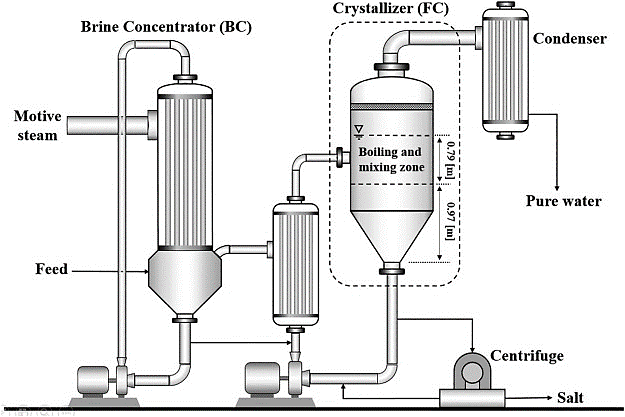
Crystallization is a physical change. Crystallization is the formation of solids from the liquid or gaseous phase. This technique includes obtaining the crystals of a soluble substance from a hot saturated solution and separating the soluble solid from the solution.
To concentrate feed into solid crystals and clean water, crystallizers are used. A progressively harder method for which crystallite sizes are formed from a liquid solution is known as crystallization. Crystallizers can remove liquid wastes completely, resulting in no liquid discharge (ZLD). The process continues and secondary crystallization are the two stages of crystallization. The formation of new crystals is referred to as primary nucleation. Secondary nucleation is the primary stage that results in the mass production of crystals. There are two types of crystallization processes: evaporative crystallization and cooling crystallization.
Main nucleation and secondary nucleation are the two ways within the crystallization course of action. New crystals improvement is referred to as Main nucleation. Secondary nucleation is the key stage that contributes to the bulk formation of crystals and is what keeps progress heading.
The salts are discharged by opening the flanged protect. The salt basket is perfect for combined salts with major crystal salts like sodium sulphate or sodium chloride which might be immediately dewatered.
The higher drinking water evaporation amount of forty eight.0 kg m−two on a daily basis accomplished because of the photo voltaic crystallizer array in out of doors industry test also suggests its fantastic probable for practical brine treatment. More enhancements while in the efficiency with the solar crystallizer might be multi-faceted, like although not restricted to implementing synthetic wind subject to reinforce environmental thermal Strength harvesting, optimizing array assembly. The solar crystallizer is considered broadly relevant to varied crystallization processes, including salt Restoration from squander brines, salt mineral extraction from salt lake, and thus is a significant contribution on the challenging problem of industrial brine procedure with ZLD.
In this particular, the liquid to be crystallized is great right down to a temperature lessen in comparison to the equilibrium solubility, generally the solubility from the liquid raises with rising temperature. In these types of cases, cooling of crystallization is generally a lot more Electricity-welcoming than evaporation crystallization.
To substantiate the lengthy-expression operational stability, the solar crystallizer was consistently illuminated through the simulated daylight (one kW m−two) for 288 h in lab conditions to deal with concentrated SWRO brine with NTA. There was no handbook salt removing through the photo voltaic crystallizer and just the self-defoliated salt crystals were periodically collected over the Procedure. Throughout the total screening period of time, the overall performance with the photo voltaic crystallizer was mainly stable and a mean evaporation charge of two.
Being inspired via the salt dilution and salt secretion mechanism of halophyte, Zhang et al. [27] prepared an evaporator capable of floor salt secretion and edge salt dilution using glass fiber felt and Polypyrrole (PPy). Sun et al. [28] 3D-printed conical PLA constructions with concave grooves by mimicking mussel seashells and after that coated the best layer with the evaporator with PPy to realize freshwater selection.
The dense salt crust surface layer combined with the salt crystals filling inside the QGF membrane in the situation from the concentrated SWRO brine brings about the failure from the 3D crystallizer through the long run operations.
The secure solar Electrical power input, highly porous framework from the salt crust layer as well as unobstructed drinking water channels In the QGF membrane all lead to the steady h2o evaporation fee from the 3D solar crystallizer for managing even really highly concentrated NaCl brines. In common 2D photo voltaic crystallizers, owing to the coincidence of their gentle absorption and salt precipitation surfaces, they're able to only deliver a small drinking water evaporation level in treating NaCl brines (e.
The conventional brine crystallizers use electrical power or fossil gasoline to warmth the brines for bulk water evaporation and thus salt crystallization with large Electrical power usage (>fifty kWh m−3)12,16,seventeen. Moreover, the usage of tension container constructed from high priced corrosion resistant materials delivers large money price of the brine crystallizers12,16. The appliance of evaporation pond, on the other hand, is limited by its restricted capability, significant land Price tag, and low solar Power efficiency18,19. For that reason, the crystallization system has long been the bottleneck of the ZLD brine therapy, nonetheless it receives very little focus mostly due to the deficiency of new approaches.
Veolia could be the marketplace chief in industrial crystallizers which produce chemical substances for example ammonium sulfate
This whole system strategy permits guarantees on mechanical, system, and schedules for the whole scope supplied by Veolia.
These brine crystals are generally pushed by steam but in some instances can use other technology to recycle vapour to scale back Electricity intake and working expenses.
The salt layer when employing solar crystallizer to take care of Crystallizer Manufacturer Crystallizer For Zero Liquid Discharge System a pure NaCl brine, b concentrated SWRO brine and c concentrated SWRO brine with NTA.
The hollow cone-shaped buoyant layer was intended parametrically by CAD. The middle of the buoyancy layer holds the crystallizer, along with the concave groove of your buoyancy layer collects the dislodged salt crystals. The buoyancy layer also acts as an insulator, lowering the heat transfer involving the crystallizer and the brine. According to the buoyancy method (1) and the particular style and design information in the buoyancy layer, it could be calculated that the amount of brine discharged by the buoyancy layer was 158.